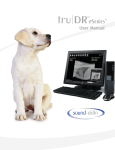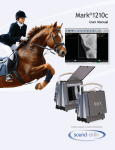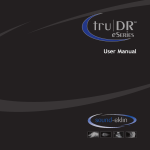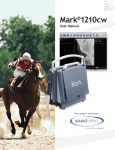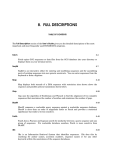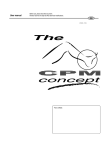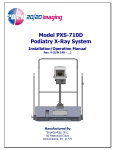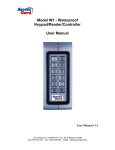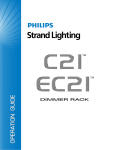Download Mark X User Manual (English)
Transcript
™ User Manual ™ Table of Contents Mark X™ User Manual Important Safety Information................................................................................ i Specifications ..................................................................................................iii Chapter 1: Mark X™ System ................................................................................. 1 The Mark X™ Color Panel Options..................................................................... 2 The Mark X™ Labels...................................................................................... 3 The Mark X™ Features................................................................................... 4 The Mark X™ Important Part Numbers............................................................... 5 The Mark X™ Key Connections Overview............................................................ 7 Connecting the Detector Cable f/Xmaru 1210 PCB................................................ 8 Connecting the Generator.............................................................................. 9 Powering Up the Mark X™ System.................................................................... 10 Chapter 2: Opening Mark X™ Software .................................................................. 11 Chapter 3: Adding Users.................................................................................... 13 Chapter 4: Patient Information............................................................................ 14 Searching and Adding Patients ....................................................................... 14 Editing an Existing Patient’s Information .......................................................... 16 Creating a New Study for an Existing Patient ..................................................... 16 Chapter 5: Creating Radiographs ......................................................................... 17 Choosing Anatomy and Positioning .................................................................. 17 Acquiring Radiographs ................................................................................. 19 Cropping a Radiograph................................................................................. 21 Chapter 6: Protocols.........................................................................................23 Using Protocols...........................................................................................23 Adding New Protocols................................................................................... 26 Editing Existing Protocols..............................................................................30 Renaming Protocols..................................................................................... 31 Deleting Protocols....................................................................................... 33 07202011 Sound-Eklin™ ™ Mark X™ User Manual Table of Contents (continued) Chapter 7: Managing Studies............................................................................... 35 Adding New Images to an Existing Study............................................................ 35 Reviewing a Study....................................................................................... 36 Chapter 7: Managing Studies............................................................................... 37 Chapter 8: Exporting Images to a Folder................................................................ 39 Chapter 9: Transferring Studies to the Storage Station............................................... 41 Transferring Individual Studies to the Storage Station........................................... 43 Transferring DICOM Batch to the Storage Station.................................................44 Confirm Storage of a Study............................................................................ 45 Chapter 10: Adding and Editing a DICOM Location.....................................................46 Appendix A: Digital Radiography Technique Charts................................................... 49 Portable 80/15........................................................................................... 49 Portable 100/30.......................................................................................... 52 Gantry.....................................................................................................54 Appendix B: Mark X™ System Field Replacement Guide..............................................56 Appendix C: Calibration Procedure.......................................................................60 Appendix D: Technical Support............................................................................ 62 Sound-Eklin™ Page 3 Important Safety Information Note Read all the instructions before connecting or operating the component Keep this manual so you can refer to these safety instructions. Warning There are no user serviceable parts inside. Refer all servicing to qualified service personnel. To reduce the risk of fire or electric shock, do not expose the unit to moisture or water. Do not allow foreign objects to get into the enclosure. If the unit is exposed to moisture, or a foreign object gets into the enclosure, immediately disconnect the power cord from the wall. Take the unit to a qualified service person for inspection and necessary repairs. Caution Heed all warnings and safety information in these instructions and on the product itself. Follow all operating instructions. Clean the enclosure only with a dry cloth or a vacuum cleaner. Clean the DR plate with a damp cloth. Use no chemicals or alcohol. IPXO per IEC 60529 Type B per IEC 60601-1 You must allow 10 cm or 4 inches of unobstructed clearance around the unit. Do not place the unit on a bed, sofa, rug, or similar surface that could block the ventilation slots. If the component is placed in a bookcase or cabinet, there must be ventilation of the cabinet to allow proper cooling. Keep the component away from radiators, heat registers, stoves, or any other appliance that produces heat. Keep the component away from flammable materials. The unit must be connected to a power supply only of the type and voltage specified on the side panel of the unit Sound-Eklin™ Page i Important Safety Information (continued) Connect the component to the power outlet only with the supplied power supply cable or an exact equivalent. Do not modify the supplied cable in any way. Do not attempt to defeat grounding and/or polarization provisions. Do not use extension cords. Do not route the power cord where it will be crushed, pinched, bent at severe angles, exposed to heat, or damaged in any way. Pay particular attention to the power cord at the plug and where it exits the back of the unit. The power cord should be unplugged from the wall outlet if the unit is to be left unused for a long period of time. Immediately stop using the component and have it inspected and/or serviced by a qualified service agency if: · The power supply cord or plug has been damaged. · Objects have fallen or liquid has been spilled into the unit. · The unit has been exposed to rain. · The unit shows signs of improper operation · The unit has been dropped or damaged in any way Place the unit on a fixed, level surface strong enough to support its weight. Do not place it on a moveable cart that could tip over. System will become unresponsive when exposed to Electrostatic Discharge (ESD) or Electrical Fast Transient (EFT) conditions. This is the normal response to these environmental conditions. Please restart the system to return to normal operation USB ports are for keyboard and mouse only. User is responsible for evaluating the system with any devices connected to this port for compliance to IEC 60601-1-1. Ethernet port is not to be used during acquisition. User is responsible for evaluating the system with any devices connected to this port for compliance to IEC60601-1-1. Sound-Eklin™ Page ii Specifications Operation Environment: +15°C to 35°C, 30% to 75% RH, 70 to 106kPa (pressure) Storage / Transport : –10° C to 55° C, 15% to 80% RH, 70 to 106kPa (pressure) Power Requirements: 100 - 240 VAC 5.6A 50/60Hz Weight (net) 47 lbs CAUTION Risk of electric shock. Do not open. Caution: To reduce the risk of electric shock, do not remove cover. No user-serviceable parts inside. Refer servicing to qualified service personnel. This symbol is to alert the user to important operating and maintenance (service) instructions in this manual and literature accompanying the product. Sound-Eklin™ Applicable for USA, Canada or where approved for the usage. Caution: To prevent electric shock, match wide blade of plug to wide slot. Insert fully. This symbol is to alert the user to the presence of uninsulated dangerous voltages inside the product’s enclosure that may constitute a risk of electric shock. Page iii Chapter 1: Mark X™ System The Mark X™ system links seamlessly with the X-ray generator to provide the best image quality in a small, lightweight, self-contained system. The Mark X™ portable Acquisition Stations are intended to be used by Veterinarians for intermittent mobile diagnostic applications. They will connect the Mark X Device to a Xmaru 1210PCB Amorphous Silicon Digital X-Ray Detector. Sound-Eklin™ Page 1 Chapter 1: Mark X™ System (continued) The Mark X™ Color Panel Options 30-901 Red 30-900 Purple 30-904 Silver 30-902 Blue 30-899 Gun Metal 30-898 Green Sound-Eklin™ Page 2 Chapter 1: Mark X™ System (continued) The Mark X™ Labels Windows License Key is located on bottom of Electronics Box Mark X™ Electronics Box Serial number MarkX™ A–frame Serial Number, CE Markings, and Manufacture Date MODEL: MARK X INPUT POWER 120 VAC ~ 5.6A 60Hz Sound-Eklin™ EN60601-1 EN60601-1-4 Page 3 Chapter 1: Mark X™ System (continued) The Mark X™ Features Power Button with LED Light Hard Drive Activity Indicator To Hold Receptor Pigtail in Place 70–786 Neoprene Cover for Xmaru 1210PCB Detector Storage for 10–124 22’ Plate cable f/Xmaru 1210PCB Detector Sound-Eklin™ Page 4 Chapter 1: Mark X™ System (continued) The Mark X™ Important Part Numbers 94-828 Mark X™ 34-828 Mark X™, Electronics Box Assembly Sound-Eklin™ 34-827 Mark X™, A-Frame Assembly Page 5 Chapter 1: Mark X™ System The Mark X™ Important Part Numbers (continued) 10-121 Min-X-Ray Sync Cable for Mark X™ Syncs the generator’s prep and expose cycle with the computer. 90-403 10’ Ethernet Patch Cable Connects the computer to the network to allow for easy image transfers from the Mark X™ to PACS. 91-408 Xmaru 1210PCB Detector Captures digital radiographs. 10-124 22’ Detector Cable f/Xmaru 1210PCB Provides power to the plate and syncs the plate and Mark X™ System. 10-171 Equine 20’ IEC-NEMA Power Extension Cord Connects the Mark X™ to any standard U.S. 110V power outlet (Nema 5-15). Sound-Eklin™ Page 6 Chapter 1: Mark X™ System (continued) The Mark X™ Key Connections Overview 10–121 Min–X–ray Sync Cable for MarkX™ 10–124 22’ Detector Cable f/Xmaru 1210PCB 10’ Ethernet Patch Cable 24–122 Keyboard with Touch–Pad 10–171 Equine 20’ IEC–NEMA Power Extension Cord Sound-Eklin™ Page 7 Chapter 1: Mark X™ System (continued) Connecting the Detector Cable f/Xmaru 1210 PCB 1. Remove the Plate and the Plate Cable. 2. Connect the 22’ Detector cable f/Xmaru 1210PCB (10–124) by aligning the red dot and notch on the cable with the red dot and notch on the receptacle. 3. Connect plate cable to the plate if it is not already connected. 10–124 22’ Detector Cable f/Xmaru 1210PCB Sound-Eklin™ Page 8 Chapter 1: Mark X™ System (continued) Connecting the Generator The sync cable should stay connected to the generator and should be stored in the generator box. 1. Plug the Min–X–ray Sync Cable (10–121) into the Mark X™. Align by red dots on each end of the connector. 2. Plug the hand switch end of the Min–X–ray Sync Cable (10–121) into the generator hand switch port. Min–X–ray Sync Cable (10–121) Sound-Eklin™ Page 9 Chapter 1: Mark X™ System (continued) Powering Up the Mark X™ System 1. Plug the female end of the power cable into the power cable slot on the Mark X box. Plug the other end into a grounded power outlet (see page ii Power Requirements). 2. With the cables connected, turn on the Mark X™ by pressing the power button on the top of the unit. Power Button with LED Light 10-171 Equine 20’ IEC-NEMA Power Extension Cord Standard US 110v Power Outlet (NEMA 5-15) Cord Sound-Eklin™ Page 10 Chapter 2: Opening Mark X™ Software Open the Mark X™ software to begin the process of taking a radiograph. 1. Double-tap the TruDR™ icon on the desktop. This will load the TruDR™ software for acquiring digital radiographs. 2. Enter the user name and password when the login screen appears. The default login is: User Name: admin Password: admin The software will load directly into the Patient Screen if the “Remember Me” box is checked. Sound-Eklin™ Page 11 Chapter 3: Adding Users Add veterinarians and technicians to TruDR ™ . 1. Touch the Manage button in the Acquisition Screen. To access the Manage screen, the user needs to have Administrative rights. Changing items in the Manage Screen other than “Users” and “Protocols” may cause your system to function improperly. If you are concerned about making changes in the Manage Screen, please contact Technical Support at 1.800.268.5354. 2. Select the Users menu from the left side of the screen to load the Users Screen. Sound-Eklin™ Page 12 Chapter 3: Adding Users (continued) 3. Touch the Add User button in the Acquisition Screen. 4. Enter the User’s name in the First Name and Last Name fields. 5. Create a unique user name and password in the User Name and Password fields. Suggested user name: First initial of your first name plus last name (e.g. jsmith for John Smith). Passwords can be left blank for ease of use. 6. Select a Group or Groups for each user by Touching Tech or Vet. Each Group allows different permissions. You may select multiple check boxes per user: Tech: User is added to the Tech pull down list has no access to the Manage features. Vet: User is added to the Vet pull down list, has no access to the Manage features. Admin: Has full access to the Manage features. Tech Support: Should only be used by Sound-Eklin™ Tech Support 7. Touch the Save button to add the User. 8. Repeat steps 3 through 7 to add additional Users. Please note: There must be at least one TECH active in the user menu. Sound-Eklin™ Page 13 Chapter 4: Patient Information Searching and Adding Patients Search for existing patients or add new patients easily by using the filtered search fields. 1. Search for a patient in the Patient Screen by entering the Patient ID, the Patient Name, or the Owner Last Name. The patient list will automatically filter as you type. Patient list is displayed based on the User Selected Default. 2. If you do not see the patient you are searching for, Touch the Add Enter key on the keyboard to bring up the Add Patient Screen. button or press the 3. Enter the patient’s information. Patient Name and Last Name are required fields. When entering patient name and last name, DO NOT use special characters such as: % $ &. Special chracters and symbols can cause problems in the patient name fields. Sound-Eklin™ Page 14 Chapter 4: Patient Information Searching and Adding Patients (continued) 4. Touch one of the Save buttons. Save Saves the current patient and returns you to the Patient Screen. Save+ Add Saves the current patient and returns to the Add Patient Screen. Save+ Acquire Saves the current patient then opens the Anatomy/Protocol Screen. Save+ Protocol Saves the patient and brings you to the Protocol Screen to select the desired series. Sound-Eklin™ Page 15 Chapter 4: Patient Information (continued) Editing an Existing Patient’s Information Edit an existing patient’s information for future DICOM tagging. Previous exam information cannot be changed 1. Select a patient to edit from the Patient Screen. 2. Touch the Edit button. 3. Edit the information as needed. If the patient is from an owner previously entered, owner can be selected from owner list on the left hand side. 4. Touch the appropriate Save button (see Page 17). Creating a New Study for an Existing Patient Create a new study for a patient previously entered in TruDR™ . 1. Search for a patient in the Patient Screen by entering the Patient ID, the Patient Name, or the Owner Last Name. The Patient List will automatically filter as you type. 2. Select a patient by Touching on the name in the Patient List. 3. Touch the New button to create a new study. 4. Select the anatomy and the view from the Anatomy Screen (see Page 19). Sound-Eklin™ Page 16 Chapter 5: Creating Radiographs Choosing Anatomy and Positioning Choose the anatomy and positioning to automatically enhance and position the radiograph. 1. Select the Tech and ordering Vet from the drop-down menus. 2. Touch the Mark X™ touchscreen and select the appropriate anatomy. Sound-Eklin™ Page 17 Chapter 5: Creating Radiographs Choosing Anatomy and Positioning (continued) 3. Touch on the appropriate view button for the exposure. This will bring you to the acquisition screen. Sound-Eklin™ Page 18 Chapter 5: Creating Radiographs (continued) Acquiring Radiographs 1. Set the X-ray generator according to the Sound-Eklin™ Technique Chart using the appropriate KVP and mAs (depending on the X-ray generator). Due to variations between X-ray generators, optimal techniques may vary somewhat from the values printed on the Sound-Eklin™ Technique Chart. Users should be fully acquainted with State and local regulations governing radiation protection and the use of diagnostic X-ray equipment as well as the manual for the X-Ray Generator being used. 2. Align the generator 22 inches from the plate using the light beam to fill the entire capture area defined on the plate. If the generator is aligned perpendicular, the light will form a rectangle with even sides filling the capture area. The image capture area is highlighted by a white box with the dotted cross-hairs in the middle. 3. From the Acquisition Screen press the hand switch halfway down to prep and all the way down to expose the X-ray machine. Proper Two-Stage Hand Switch Technique 1. To Prep, push the hand switch halfway down. 2. Wait until the Generator is ready to fire (i.e. prep light on the X-ray machine is illuminated, etc.). 3. To expose, push the hand switch completely down . Sound-Eklin™ Page 19 Chapter 5: Creating Radiographs Acquiring Radiographs (continued) 4. The image will appear in less than 3 seconds. Use the Use Left, Right, Flip, Reverse, ROI or Crop buttons to make orientation adjustments before shooting the next shot. ‘Window’ and level with finger in up and down, left or right motion. Crop the images as needed (see Pages 23-24). If you need to reshoot your X-ray, press the hand switch and fire again. 5. Touch the Anatomy button to change views. 6. Select the next view from the Views Screen. Touch the Anatomy button from the Views Screen if another anatomy is needed. 7. Touch the Review button to review. Touch the Patient button to return to the Patient Screen. Sound-Eklin™ Page 20 Chapter 5: Creating Radiographs (continued) Cropping a Radiograph Remove unwanted portions of the radiograph. 1. Make adjustments before shooting the next radiograph. To do so, Touch the Action button. Touch the Crop button in the Acquisition Screen. The new image will appear lighter after Touching the crop button. Based on the crop selection the image will be windowed and leveled again. Sound-Eklin™ Page 21 Chapter 5: Creating Radiographs Cropping a Radiograph (continued) 2. Frame the desired image dragging from upper left corner to lower right hand corner of the touchscreen with finger. 3. The image will enhance once it is cropped. The image will perform an ROI based on crop size. 4. Re-crop the image if necessary before taking the next radiograph by repeating the steps. Sound-Eklin™ Page 22 Chapter 6: Protocols Using Protocols Shoot a series of X-rays in a preset order which automatically advances to the next shot after each shot taken. 1. From the Patient Screen, select the Patient and Touch Protocol. Or, from the Patient Screen, Touch New and Touch Protocol. OR, from the Add Patient or Edit Patient screen, Touch Save + Protocol. (to Add a Patient see page 16). Sound-Eklin™ Page 23 Chapter 6: Protocols Using Protocols (continued) 2. Select a Protocol button to begin the protocol series. 3. The Acquisition Screen now has a Protocol Information bar showing the Protocol shot number. The current Shot Information is located in the upper left portion of the screen. Sound-Eklin™ Page 24 Chapter 6: Protocols Using Protocols (continued) 4. Shoot the first image. The software will automatically advance to the next shot in the protocol series. The shot number in the Protocol Information Bar keeps track of the shot sequence, while the current Shot Information appears in the upper left. 5. Use the Protocol Information bar to repeat a shot, skip a shot, restart the protocol, move to the last shot in the protocol, or stop the protocol. Move to the first shot in the protocol series Repeat the previous shot Skip to the next shot Skip to the last shot in the protocol series Stop the protocol 6. Touch the Review button to open the Review screen (see Page 25). 7. Touch the Patient button to return to the Patient Screen. Sound-Eklin™ Page 25 Chapter 6: Protocols (continued) Adding New Protocols Create new protocols for your individual studies. 1. Touch the Actions button to access the Manage button in the Patient Screen. To access the Manage screen, the user needs to have Administrative rights. Changing items in the Manage Screen other than “Users” and “Protocols” may cause your system to function improperly. If you are concerned about making changes in the Manage Screen, please contact Technical Support at 1.800.268.5354. Sound-Eklin™ Page 26 Chapter 6: Protocols Adding New Protocols (continued) 2. Touch on the Plus Sign next to the Protocols List to show the existing protocols. 3. Select the Protocols menu from the left side of the screen to load the Protocol Screen. Navigate to Species > Equine > 1210S CIE > Protocol. 4. Enter the name of your new protocol in the Protocol Name field. 5. Touch the Save button. Sound-Eklin™ Page 27 Chapter 6: Protocols Adding New Protocols (continued) 6. Filter the shots as necessary by selecting the Filter by Laterality drop down menu. 7. Select the first shot from the Shots for Species list. 8. Touch the Link button Sound-Eklin™ to add the shot to the Shots Linked to Protocol box. Page 28 Chapter 6: Protocols Adding New Protocols (continued) 9. Repeat step 6 through 8 as necessary. 10. Touch the Unlink button to remove any shots from the Shots Linked to Protocol box. 11. Select a shot in the Shots Linked to Protocol box and change the order using the Move Up, Move Down, Move First, and Move Last buttons. Moves your protocol shot up one shot in the series. Moves your protocol shot down one shot in the series. Moves your protocol shot from its location to the first shot in the series. Moves your protocol shot from its location to the last shot in the series. 12. Touch the Save button to save your protocols. 13. Touch the Patient button to return to the Patient Screen. If you have forgotten to save your protocols, a Save dialogue box will appear. Touch the Yes button to save your changes and return to the Patient Screen. Sound-Eklin™ Page 29 Chapter 6: Protocols (continued) Editing Existing Protocols Edit current Protocols to customize them to your shot series. 1. Touch the Actions button to access the Manage button in the Patient Screen. To access the Manage screen, the user needs to have Administrative rights. Changing items in the Manage Screen other than “Users” and “Protocols” may cause your system to function improperly. If you are concerned about making changes in the Manage Screen, please contact Technical Support at 1.800.268.5354. 2. Touch on the Plus Sign next to the Protocols list to show the existing protocols. 3. Select a Protocol to edit from the left side menu, make changes and Touch Save. Sound-Eklin™ Page 30 Chapter 6: Protocols Editing Existing Protocols (continued) 4. Continue with Step 8 on Page 34. Closing the software and re-opening is required to save protocol database changes. Renaming Protocols Rename current protocols. 1. Touch the Actions button to access the Manage button in the Patient Screen. To access the Manage screen, the user needs to have Administrative rights. Changing items in the Manage Screen other than “Users” and “Protocols” may cause your system to function improperly. If you are concerned about making changes in the Manage Screen, please contact Technical Support at 1.800.268.5354. Sound-Eklin™ Page 31 Chapter 6: Protocols Renaming Protocols (continued) 2. Touch on the Plus Sign next to the Protocols List to show the existing protocols. 3. Select the Protocol to rename from the left side menu. Touch the Rename button. 4. Rename the protocol in the text box and Touch the OK button when finished. 5. Restart the software by touching Exit from the Main Patient Screen Sound-Eklin™ Page 32 Chapter 6: Protocols (continued) Deleting Protocols Delete current protocols. 1. Touch the Actions button to access the Manage button in the Patient Screen. To access the Manage screen, the user needs to have Administrative rights. Changing items in the Manage Screen other than “Users” and “Protocols” may cause your system to function improperly. If you are concerned about making changes in the Manage Screen, please contact Technical Support at 1.800.268.5354. 2. Touch on the Plus Sign next to the Protocols List to show the existing protocols. 3. Select the Protocol to delete from the left side menu Touch the Delete button. Sound-Eklin™ Page 33 Chapter 6: Protocols Deleting Protocols (continued) 4. Touch the OK button to permanently remove the protocol. 5. Restart the software by Touching the close button in the upper right corner. Sound-Eklin™ Page 34 Chapter 7: Managing Studies Adding New Images to an Existing Study Add new images to an existing patient’s study. 1. Search for a patient in the Patient Screen by entering the Patient ID, the Patient Name, or the Owner Last Name. The Patient List will automatically filter as you type. 2. Touch the Acquire button. This will take you to the Views Screen using the anatomy you selected from the original study. This is shown in the description field. Sound-Eklin™ Page 35 Chapter 7: Managing Studies (continued) Reviewing a Study Change the layout or delete any unwanted images before the study is archived on the Storage Station. 1. Select a patient by Touching on the name in the Patient List. 2. Touch on the Study from the list on the right. 3. Touch the Review button. 4. Select a thumbnail in the left-hand pane to load the image into the review pane on the right. The selected image is highlighted by a yellow box. Sound-Eklin™ Page 36 Chapter 7: Managing Studies Reviewing a Study (continued) 5. Review the images by using the following techniques: Zoom: Once the Zoom button is selected tap the screen on area you would like to Zoom in on. To Zoom out tap revert button. Pan: Tap the Pan button, Touch and drag the image with your finger. Window Level: Tap Window Level button, Move up and down with finger on screen to perform Level. Dragging finger Left to Right is Window. 6. Use the toolbar for advanced review features. Patient: Returns to the Patient Screen. New: Opens the Anatomy/Protocol Screen for creating a new study or protocol. Acquire: Opens the Views Screen using the anatomy you selected from the original study. Anatomy: Opens the Anatomy/Protocol Screen to select a new view to add into the same study. Save: Saves the image with any changes that have altered the original image. Warning message will appear to choose “Yes” to overwrite (replace) the image or “No” to create a new (additional) image. Delete: Removes any unwanted images. Deleting an image permanently removes it from the computer. Sound-Eklin™ Page 37 Chapter 7: Managing Studies Reviewing a Study (continued) Revert: Reverts to the original image. Left: Rotates the image 90˚ counterclockwise. Right: Rotates the image 90° clockwise. Flip: Flips the image vertically. Reverse: Flips the image horizontally. Magnify: Activates the magnifier which will zoom on the selected area. Actions: Shows a drop-down menu with additional review features. Win Level: Selects the window level feature (also accessible by using the right mouse button). Invert: Inverts blacks and whites, replicating a fluoroscopy. Pan: Pans the image (also accessible by using the left mouse button). Crop: Trims an image without applying enhancements. In the Review Screen, cropping does not re-enhance the image based on the captured area. It only trims the image without re-enhancing the image. Overlay: Opens menu for DICOM text display. Hide: Hides all DICOM information. Summary: Displays patient and shot information. Detail: Displays patient, shot, and additional detailed information. ROI: Draw a box from left to right to window and level based on the Region of Interest. 7. Touch the Patient button to return to the Patient Screen. Sound-Eklin™ Page 38 Chapter 8: Exporting Images to a Folder Export images from a study to a folder to save on a computer, thumb drive, etc. 1. Search for a patient in the Patient Screen by entering the Patient ID, the Patient Name, or the Owner Last Name. The Patient List will automatically filter as you type. 2. Select a patient and a study. The patient and study are highlighted in a blue box. 3. Touch the Folder button. 4. Select either the DICOM or JPEG image format from the Export As: drop-down menu. 5. When selecting the DICOM option from Step 4, Touch the Add DICOM viewer check box only if the computer does NOT have a full DICOM viewer already installed. Annotation Burning Imprints annotations made to saved images Anonymize Images Strips all client and clinic information from the images Repository Format Places images in a repository folder format Create DICOM DIR Adds a DICOM directory to quickly import all images into a PACS system. Sound-Eklin™ Page 39 Chapter 8: Exporting Images to a Folder (continued) 6. When selecting the JPEG format from Step 4, select the Overlay Burning options from the drop-down menu: The default option is set to None: None: Does not show overlays on the JPEG image Detail: Shows a detailed DICOM overlay on the JPEG image (shows Image Number, Manufacturers Model Number, Study ID, Image Anatomy, View Position, Image Laterality Extended, Columns X Rows, Technique, Institution Name, Physician of Record, Patients Name, Patient ID, Patient Breed Description, Patients Birth Date, Patients Sex, Acquisition Number, Acquisition Date, Acquisition Time.) Summary: Shows a summary DICOM overlay on the JPEG image (shows Image Number, Image Anatomy, View Position, Image Laterality Extended, Institution Name, Physician of Record, Patients Name, Patient Breed Description, Patients Birth Date, Patients Sex, Acquisition Date, Acquisition Time). 7. Touch the Select Button 8. Select a location to save the images. Images are saved to a selected location in a folder with the animals name and the clients last name (e.g. Trigger-Smith). Sound-Eklin™ Page 40 Chapter 9: Transferring Studies to the Storage Station Transfer the studies from the Acquisition Station to the Storage/Review Station. You must have your Mark X™ and your Storage/Review Station networked. Please contact your local IT Person for any networking needs and SoundEklin tech support for configuring DICOM Server for the Mark X. Unit cannot be connected to a network while in use. In addition you must remove network plug 1. Connect a Cat-5 Internet cable into the Internet port on the computer. 2. To bring up the Store Files to DICOM Server screen, Touch the Server Button on the Patient Screen. Sound-Eklin™ Page 41 Chapter 9: Transferring Studies to the Storage Station (continued) 3. Touch the Start Store button to begin the DICOM image transfer to the Storage Station. This will store all the studies that were taken since your last transfer and clear the queue. If any studies are missing, you can transfer them individually (see the following section). 4. Status box displays transfer results. When the status box states “completed”, your images have successfully transferred to the DICOM server. Touch the Red close button in the upper right corner to close the screen. Sound-Eklin™ Page 42 Chapter 9: Transferring Studies to the Storage Station (continued) Transferring Individual Studies to the Storage Station Transfer the studies from the Acquisition Station to the Storage/Review Station. 1. Search for a patient’s study by entering the Patient ID, the Patient Name, or the Owner Last Name. The Patient List will automatically filter as you type. 2. Select a patient by Touching on the patient name in the Patient List field. 3. Touch the Server button. 4. Touch the Start Store button to begin DICOM image transfer. Sound-Eklin™ Page 43 Chapter 9: Transferring Studies to the Storage Station Transferring Individual Studies to the Storage Station (continued) 5. Status box displays transfer results. When the status box states “completed”, your images have successfully transferred to the DICOM server. Touch the Red close button in the upper right corner to close the screen. Transferring DICOM Batch to the Storage Station 1. If you wish to send a group of selected studies from a specific timeframe, enter the start and end date of these studies in the display at the top of the Batch Send Options window.. The Dicom image transfer will send thes studies listed in the queue all at once. 2. Touch the Start Store button to begin DICOM image transfer. Sound-Eklin™ Page 44 Chapter 9: Transferring Studies to the Storage Station (continued) Confirm Storage of a Study Confirm the study successfully sent to the Storage/Review Station. 1. On the Patient Screen, the Archive field will show a server name (e.g. SOUND-SERV1). 2. Hold the mouse over the server name to show a pop-up window with the transfer data. The pop-up box displays how many images have been transferred and the date and time of the transfer. The information is color coded for easy reference. If only one study appears, it will be highlighted in blue and the color coding will not appear: Green Box— Image transfer complete Red Box — Image transfer failed Notice the Secondary Transfer field. Secondary Transfer documents the number of studies sent to another PACS system besides the main archive, ie Sound-Serv2. Sound-Eklin™ Page 45 Chapter 10: Adding and Editing a DICOM Location Add DICOM server locations for sending images to a Storage Station, Radiologist, etc. 1. Touch the Manage button in the Acquisition Screen. To access the Manage Screen, the user needs to have Admin rights. Chang-ing items in the Manage Screen other than “Users” and “Protocols” may cause your system to function improperly. If you are concerned about making changes in the Manage Screen, please contact Technical Support at 1.800.268.5354. 2. Select the Configuration menu from the left side of the screen to load the Users screen. Sound-Eklin™ Page 46 Chapter 10: Adding and Editing a DICOM Location (continued) 3. Select the DICOM button from the left to bring up the DICOM Server Screen. 4. Touch the Add button to add a new DICOM server. Or if editing select the existing DICOM server from the DICOM Servers list on the Right. 5. Enter the AE Title, IP Address, and Port number for your DICOM server. OR if editing enter the corrected AE Title, IP Address, and Port number for your DICOM server. Contact Sound-Eklin™ Technical Support or the location you are sending the DICOM images for the appropriate DICOM provider information. 6. Select additional information by choosing Yes from the drop-down menus. Only select the following options if you are directed to do so by a Technical Support representative: Auto Send Server: Automatically sends images to the selected DICOM location. Allow Worklist: Designates the DICOM location as a worklist modality. Telemedicine Server: Designates the DICOM location as a telemedicine server. Archive Server: Designates the DICOM location as an archive server. 7. Touch the Save button Sound-Eklin™ to save the current information. Page 47 Chapter 10: Adding and Editing a DICOM Location 8. Touch the Verify button 9. A smiley face (continued) to verify that you can connect to the DICOM Server. will appear when you have verified the connection to the DICOM Server. If a frowning face appears, please contact Sound-Eklin™ Technical Support (1.800.268.5354). 10. Touch the Patient button to return to the Patient Screen. Sound-Eklin™ Page 48 Appendix A: Digital Radiography Technique Charts Portable 80/15 Study View SID in/cm kVP Time in Seconds 65 Degree Navicular 24/61 65 0.2 65 Degree P-3 24/61 80 0.05 DP 24/61 80 0.1 Lateral 24/61 80 0.1 Flexor Skyline 18/46 80 0.1 If Indicated Nav. Obliques 24/61 80 0.1 If Indicated 65 P-3 Obl. 24/61 80 0.05 P-3 Lateral 24/61 80 0.1 65 Degree P-3 24/61 80 0.05 65 Degree Obliques 24/61 80 0.05 DP 24/61 80 0.1 Lateral 24/61 80 0.1 Medial Oblique 24/61 80 0.1 Lateral Oblique 25/64 80 0.1 DP 24/61 80 0.1 Medial Oblique 24/61 80 0.1 Lateral 24/61 80 0.1 Lateral Oblique 24/61 80 0.1 Flexed Lateral 24/61 80 0.1 Special Palmar 24/61 80 0.1 DP 24/61 80 0.07 Lateral 24/61 80 0.07 Medial Oblique 24/61 80 0.07 Lateral Oblique 24/61 80 0.07 Navicular If Indicated Pastern Fetlock If Indicated Metacarpus/Metatarsus Sound-Eklin™ Page 49 Appendix A: Digital Radiography Technique Charts Portable 80/15 (continued) Study View SID in/cm kVp Time in Seconds DP 24/61 80 0.1 Medial Oblique 24/61 80 0.1 Lateral 24/61 80 0.1 Lateral Oblique 24/61 80 0.1 Flexed Lateral 24/61 80 0.1 Distal Rad. Sky 18/46 80 0.1 Distal Row Sky 18/46 80 0.1 Prox. Row Sky 18/46 80 0.1 DP 24/61 80 0.15 Medial Oblique 24/61 80 0.1 Angle Down 5 Lateral 24/61 80 0.1 Angle Up 5 Lateral Oblique 24/61 80 0.1 If Indicated Calcaneal Skyline 18/46 80 0.1 DV 24/61 80 0.25 Lateral 24/61 80 0.25 Right Oblique 24/61 80 0.25 Left Oblique 24/61 80 0.25 DV 24/61 80 0.2 Lateral 24/61 80 0.2 Right Oblique 24/61 80 0.2 Left Oblique 24/61 80 0.2 Cranial (Lateral) 24/61 80 0.2 Middle (Lateral 24/61 80 0.25 Caudal (Lateral) 24/61 80 0.3 Carpus If Indicated If Indicated Tarsus Skull (TMJ & Bullae) Sinus/Dental Cervical Spine Sound-Eklin™ Page 50 Appendix A: Digital Radiography Technique Charts Portable 80/15 (continued) Study View SID in/cm kVp Time in Seconds Pharynx Lateral 24/61 80 0.25 Shoulder Lateral 24/61 80 0.4 Elbow Cran->Caud 24/61 80 0.3 Medio-Lateral 24/61 80 0.2 Cran->Caud 24/61 80 0.2 Lateral 24/61 80 0.2 Caud->Cran 24/61 80 0.3 Lateral 24/61 80 0.2 Lateral Oblique 24/61 80 0.2 Caud->Cran 24/61 80 0.2 Lateral 24/61 80 0.2 Lateral 24/61 80 0.1 Radius Stifle Tibia Withers Sound-Eklin™ Page 51 Appendix A: Digital Radiography Technique Charts (continued) Portable 100/30 Study View SID in/cm kVp mAs 65 Degree Navicular 30/76 80 3.2 65 Degree P-3 30/76 80 0.5 DP 30/76 80 1.7 Lateral 30/76 80 1.7 Flexor Skyline 18/46 80 1.7 If Indicated Nav. Obliques 30/76 80 1.7 If Indicated 65 P-3 Obl. 30/76 80 0.5 Lateral 30/76 80 1.7 65 Degree P-3 30/76 80 0.5 65 Degree Obliques 30/76 80 0.5 DP 30/76 80 1.7 Lateral 30/76 80 1.7 Medial Oblique 30/76 80 1.7 Lateral Oblique 30/76 80 1.7 DP 30/76 80 1.7 Medial Oblique 30/76 80 1.7 Lateral 30/76 80 1.7 Lateral Oblique 30/76 80 1.7 Flexed Lateral 30/76 80 1.7 Special Palmar 30/76 90 1.7 DP 30/76 80 1.7 Lateral 30/76 80 1.7 Medial Oblique 30/76 80 1.7 Lateral Oblique 30/76 80 1.7 DP 30/76 80 1.7 Medial Oblique 30/76 80 1.7 Lateral 30/76 80 1.7 Lateral Oblique 30/76 80 1.7 Flexed Lateral 30/76 80 1.7 Distal Rad. Sky 18/46 80 1.7 Distal Row Sky 18/46 80 1.7 Prox. Row Sky 18/46 80 1.7 Navicular P-3 If Indicated Pastern Fetlock If Indicated Metacarpus/Metatarsus Carpus If Indicated If Indicated Sound-Eklin™ Page 52 Appendix A: Digital Radiography Technique Charts Portable 100/30 (continued) Study View SID in/cm kVp mAs DP 30/76 80 1.7 Medial Oblique 30/76 80 1.7 Angle Down 5 Lateral 30/76 80 1.7 Angle Up 5 Lateral Oblique 30/76 80 1.7 If Indicated Calcaneal Skyline 18/46 80 1.7 Flexed DP 30/76 100 1.7 DV 30/76 100 2.5 Lateral 30/76 100 1.4 Right Oblique 30/76 100 1.4 Left Oblique 30/76 100 1.4 DV 30/76 100 2.5 Lateral 30/76 80 1.7 Right Oblique 30/76 80 1.7 Left Oblique 30/76 80 1.7 Cranial (Lateral) 30/76 100 1.7 Middle (Lateral) 30/76 100 2 Caudal (Lateral) 30/76 100 2.5 Pharynx Lateral 30/76 80 1.7 Shoulder Lateral 30/76 100 3 Cran->Caud 30/76 100 1.4 Medio-Lateral 30/76 100 1.7 Cran->Caud 30/76 80 1.7 Lateral 30/76 80 1.7 Obliques 30/76 80 1.7 Caud->Cran 30/76 100 2 Lateral 30/76 80 1.7 Lateral Oblique 30/76 80 1.7 Patellar Skyline 18/46 80 1.7 Caud->Cran 30/76 100 1.4 Lateral 30/76 80 1.7 Obliques 30/76 80 1.7 Lateral 30/76 80 1.2 Tarsus Skull (TMJ & Bullae) Sinus/Dental Cervical Spine Elbow Radius Stifle Tibia Withers Sound-Eklin™ Page 53 Appendix A: Digital Radiography Technique Charts (continued) Gantry Study View SID in/cm kVp mAs Navicular DP 40/102 65 5 DP P3 40/102 80 2 Foot DP 40/102 80 3.2 Lateral 40/102 80 3.2 Navicular Navicular Skyline 40/102 80 3.2 If Indicated Nav. Obliques 40/102 80 2 If Indicated P3 Obliques 40/102 80 2 Lateral 40/102 80 3.2 DP P3 40/102 80 2 P3 Obliques 40/102 80 2 DP 40/102 80 3.2 Lateral 40/102 80 3.2 Dlpmo 40/102 80 3.2 Dmplo 40/102 80 3.2 DP 40/102 80 3.2 Dlpmo 40/102 80 3.2 Lateral 40/102 80 3.2 Dmplo 40/102 80 3.2 Flexed Lateral 40/102 80 3.2 Special Palmar 40/102 80 3.2 DP 40/102 80 3.2 Lateral 40/102 80 3.2 Medial Oblique 40/102 80 3.2 Lateral Oblique 40/102 80 3.2 DP 40/102 80 3.2 Dlpmo 40/102 80 3.2 Lateral 40/102 80 3.2 Dmplo 40/102 80 3.2 Flexed Lateral 40/102 80 3.2 Distal Rad. Sky 40/102 80 3.2 Distal Row Sky 40/102 80 3.2 Prox. Row Sky 40/102 90 3.2 P-3 If Indicated Pastern Fetlock If Indicated Metacarpus/Metatarsus Carpus If Indicated If Indicated Sound-Eklin™ Page 54 Appendix A: Digital Radiography Technique Charts Gantry (continued) Study View SID in/cm kVp mAs DP 40/102 95 3.2 Dlpmo 40/102 80 3.2 Angle Down 5 Lateral 40/102 80 3.2 Angle Up 5 Dmplo 40/102 80 3.2 If Indicated Calcaneal Skyline 40/102 80 3.2 DV 40/102 100 4 Lateral 40/102 90 3.2 Right Oblique 40/102 90 3.2 Left Oblique 40/102 90 3.2 DV 40/102 100 3.2 Lateral 40/102 90 3.2 Right Oblique 40/102 90 3.2 Left Oblique 40/102 90 3.2 Cranial (Lateral) 40/102 90 3.2 Middle (Lateral 40/102 100 4 Tarsus Skull (TMJ & Bullae) Sinus/Dental Cervical Spine Caudal (Lateral) 40/102 110 15 Pharynx Lateral 40/102 90 3.2 Shoulder Lateral 40/102 110 15 Cran->Caud 40/102 110 4 Medio-Lateral 40/102 90 3.2 Cran->Caud 40/102 100 3.2 Lateral 40/102 90 3.2 Caud->Cran 40/102 110 12 Lateral 40/102 90 8 Pldmo 40/102 95 3.2 Caud->Cran 40/102 100 8 Lateral 40/102 90 6 Lateral 40/102 100 4 Elbow Radius Stifle Tibia Withers Sound-Eklin™ Page 55 Appendix B: Mark X™ System Field Replacement Guide 1 3 2 4 1. Using a Phillips screwdriver remove four (4) screws. 2. Box will remain on because of 3 Guide Pins. Gently slide electronics box off Guide pins, By pulling back. There are no wires to disconnect. 1 3 2 Blind Mate Connector Sound-Eklin™ Page 56 Appendix B: Mark X™ System Field Replacement Guide (continued) 3. Flip electronics box over and pull out 16GB Compact Flash Card. The compact flash card will have the most recent Database file on it with all settings required to restore. You will need to place the old Compact Flash into the new electronics box replacement. X To Slide out old 16GB CF via the cut out: Gently pull left or right tab with thumb while pulling card back towards “X”. 4. You will need to place the old Compact Flash into the new electronics box replacement. To Slide in new 16GB CF via the cut out: Gently align card up with rails and push card forwards towards “X”. Sound-Eklin™ Page 57 Appendix B: Mark X™ System Field Replacement Guide (continued) 5. After replacing CF card into new Electronics Box slide on using guide pins. The guide pins will line up the blind mate connector for you. 1 3 2 Blind Mate Connector 6. Using a Phillips screwdriver to tighten four (4) screws. 1 3 2 4 Sound-Eklin™ Page 58 Appendix B: Mark X™ System Field Replacement Guide (continued) 7. Obtain Internet Connection, Power On, then call Technical Support at 1.800.819.5538 to restore settings. Restore procedure will take roughly 20 minutes. Sound-Eklin™ Page 59 Appendix C: Calibration Procedure 1. Launch the TruDR application as Administrator (username: admin password: admin). 2. Select the Actions button located in the menu bar at the top of the screen. 3. Select the Manage button located at the top of the dropdown that appears after selecting Actions. 4. Select Equipment from the menu on the left side of the screen. 5. The Equipment Configuration screen will appear in the window on the right. At the bottom of the window select the Perform Calibration button. You may need to minimize the On-Screen Keyboard in order to see the button. To do this select the Keyboard button located in the top left corner of the screen.) 6. The Calibration screen will load on top of the application. To begin the calibration, select the Perform Gain button. Once you have done this, the application will begin to acquire a series of 4 Dark images 30 seconds apart and average them to create the Offset image. After each image is acquired, the Progress text box will read: Please Wait. 7. Next, you will be prompted to take a shot to check technique. The target value for the gain calibration is ~11000 ADU. A good starting technique at 50” SID is 80 kVp and .17 seconds 8. If the setting is correct the Calibration Progress box will display the Average Exposure Count and allow you to continue the calibration. If the settings are not correct, the Calibration Progress box will tell you if the settings are too high or too low, reset, and then prompt you to adjust your settings and take another image. (The window for acceptable values is +/ 20%.) 9. If your settings were correct, you will be prompted to acquire a series of 4 images 30 seconds apart. 10. Once all 4 gain calibration images have been created, you will be prompted to acquire a Flat Field image. Acquire this image at the same technique as your calibration images. 11. Once the Flat Field image has been acquired, the application will begin calculating the statistics of the calibration. DO NOT CLICK ANY BUTTONS OR EXIT THE SCREEN UNTIL THE STATISTICS HAVE BEEN GENERATED. Sound-Eklin™ Page 60 Appendix C: Calibration Procedure (continued) 12. Approximate Calibration Statistics: Offset Median: 2129 Offset Std Dev: 258.1529 Gain Median: 9586 Gain Std Dev: 144.6174 13. Using the dropdown window next to the Get Image button at the bottom of the Calibration Screen you can view the Offset, Gain, and Flat-Field images by selecting them in the dropdown and selecting the Get Image button. Use the Brightness and Contrast sliders at the bottom of the image window to adjust the image. 14. Select the Flat-Field image from the dropdown window and select Get Image. Inspect the image for any defective lines, pixels, or any other artifact. If the image is a mottled/uniform gray color then the calibration was successful. Sound-Eklin™ Page 61 Appendix D:Technical Support Shipping Address Sound-Eklin™ 6359 Paseo Del Lago Carlsbad . California 92011 USA Technical Support Office hours: Weekdays 8:00 A.M. — 5:00 P.M. Pacific Time Emergency 24-hour support is available. Telephone: 800-268-5354 option 3 Website www.soundeklin.com Sound-Eklin™ Page 62 Sound-Eklin™ Technical Support 6359 Paseo Del Lago Carlsbad . California 92011 USA toll free: 800.268.5354 option 3 phone:760.918.9626 fax:76.918.9620 international:+1.760.918.9626 www.soundeklin.com © 2011 All Rights Reserved Sound-Eklin™ — a VCA ANTECH company





































































